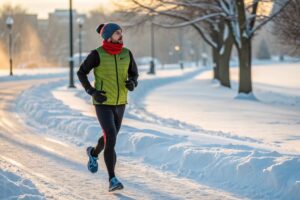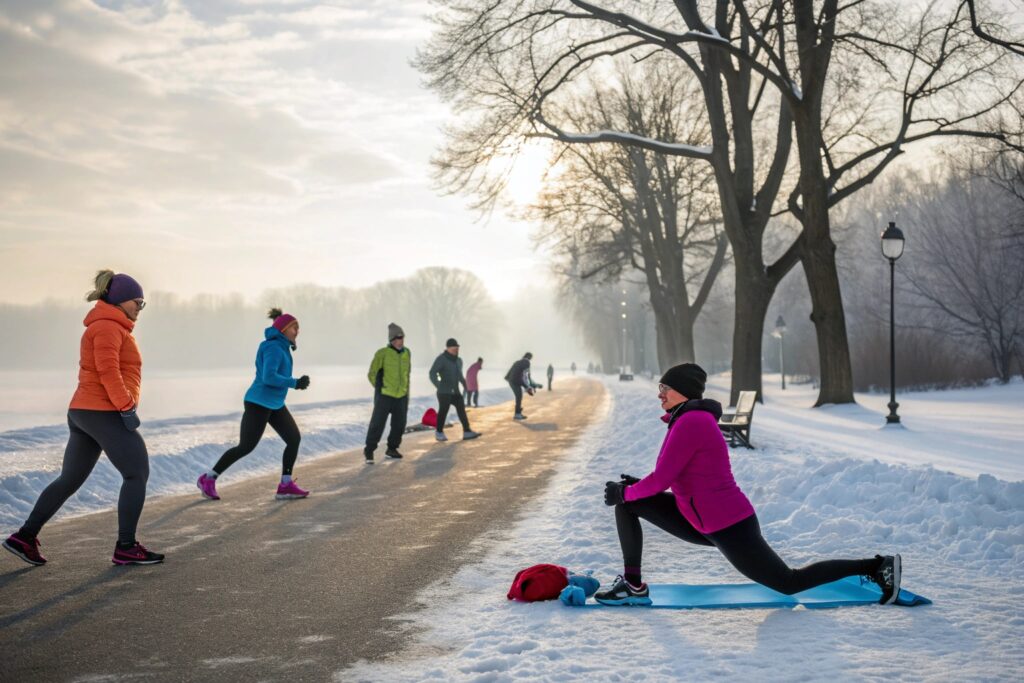Introduction
When the temperature drops and the days grow shorter, many people find it harder to keep up with their fitness routine. Winter Workout Motivation: How to Stay Active and Healthy During the Cold Months isn’t just a catchy phrase – it’s a promise that you can maintain, or even improve, your health despite the chill. By understanding the unique challenges of the season and leveraging smart strategies, you’ll discover that winter can become a powerful ally rather than an obstacle on your path to wellness.
From bundling up in the right gear to finding indoor alternatives that keep your heart rate up, this guide covers every angle you need to stay motivated, safe, and strong. Whether you’re a seasoned athlete or just starting out, the tips, workouts, and mindset tricks below will equip you with the confidence to step out of the house, hit the treadmill, or roll out a yoga mat—no matter how frosty the forecast gets.
Why Winter Can Derail Your Fitness Goals (and How to Fight Back)
Cold Weather Lowers Your Energy Levels
As the temperature falls, the body instinctively conserves energy to maintain core warmth. This metabolic shift often leaves you feeling sluggish, making it tempting to skip workouts. Understanding that this is a natural physiological response helps you plan smarter: schedule exercise at the times of day when you naturally feel most energetic, such as mid‑morning or early evening, and allow extra warm‑up time to ease your muscles into activity.
Shorter Days Can Disrupt Your Routine
The reduced daylight can impair your circadian rhythm, affecting sleep quality and mood. Poor sleep makes it harder to muster the motivation to move, while a dip in serotonin can lower overall optimism. Combat this by maximizing natural light exposure—open curtains, take brief walks during daylight hours, or use a light therapy box. Consistent sleep hygiene (same bedtime, cool dark room) also stabilizes hormone levels that drive motivation.
Essential Winter Gear to Keep You Warm and Moving

Layering: The Three‑Layer System
The secret to staying comfortable lies in layering: a moisture‑wicking base layer, an insulating mid‑layer, and a wind‑proof outer shell. The base layer pulls sweat away from the skin, preventing that chilling “wet‑shirt” feeling. The mid‑layer (fleece or lightweight down) traps heat, while the outer shell shields you from wind and snow. This combo lets you regulate temperature without overheating during high‑intensity intervals.
Footwear and Accessories
Proper footwear is crucial on icy paths. Look for shoes with robust traction, such as rubber studs or a deep lug pattern, and consider waterproof membranes to keep feet dry. Gloves with grip pads protect your hands while maintaining dexterity for weights or yoga props. A breathable beanie eliminates heat loss from the head, and a neck gaiter can be pulled down to cover the lower face on particularly frosty mornings.
Top Indoor Workouts for When the Weather Is Too Harsh

High‑Intensity Interval Training (HIIT) in Small Spaces
HIIT provides a full‑body burn in as little as 20 minutes, making it perfect for limited indoor areas. Alternate 30‑second bursts of bodyweight moves—jump squats, burpees, mountain climbers—with 30‑second rest periods. This stimulates cardiovascular fitness and preserves muscle mass, all while keeping you warm from the inside out. Use a timer app or a simple interval timer to stay on track.
Strength Training with Minimal Equipment
Invest in a set of adjustable dumbbells, resistance bands, or a kettlebell to create a versatile home gym. Compound exercises such as goblet squats, dumbbell deadlifts, and banded rows engage multiple muscle groups and boost metabolic rate. Aim for three to four sets of eight to twelve reps per exercise, progressively increasing weight or resistance each week for continued gains.
Mind‑Body Practices: Yoga and Pilates
Winter is an excellent time to focus on flexibility, balance, and mental clarity. Yoga sequences that emphasize hip openers, hamstring stretches, and shoulder mobility counteract the tightness that often accompanies colder weather. Pilates, with its emphasis on core stability and controlled breathing, also helps maintain posture and prevents injuries caused by slippery surfaces outdoors.
Outdoor Winter Activities That Double as Effective Cardio
Snowshoeing: Low‑Impact, High‑Calorie Burn
Snowshoeing mimics the benefits of jogging while offering a low‑impact alternative that’s easier on joints. Strapping on a pair of snowshoes engages the glutes, calves, and core, providing a solid cardio workout that can burn 400‑600 calories per hour depending on intensity and terrain. Choose trails with varied elevation for added interval training.
Cross‑Country Skiing for Full‑Body Conditioning
Cross‑country skiing is often hailed as one of the most efficient full‑body exercises. It activates both upper and lower body muscles, enhances aerobic capacity, and improves coordination. Even a 30‑minute session on groomed trails can rival a traditional treadmill run in terms of calorie expenditure, making it perfect for athletes seeking a challenging winter cardio option.
Cold‑Weather Cycling: Benefits and Safety Tips
Fitted with winter tires and layered clothing, cycling in the cold can be exhilarating and effective. It promotes lower‑body strength, improves cardiovascular health, and encourages mental resilience. Always prioritize visibility (bright clothing, lights) and keep a repair kit handy. Short, high‑intensity rides can offset the slower metabolism that often accompanies frigid temperatures.
Staying Motivated: Mindset Hacks and Goal Setting for Cold‑Weather Success

Set Specific, Seasonal Goals
Instead of generic “stay fit” resolutions, define clear objectives that align with winter conditions—e.g., “Complete three snowshoe sessions per week” or “Increase indoor HIIT sessions from two to four per week.” Concrete goals create measurable progress and provide a psychological boost each time you check them off.
Leverage Social Support and Accountability
Join a local winter sports club, sign up for an online challenge, or pair up with a workout buddy. Sharing your journey on social media or fitness apps not only holds you accountable but also introduces an element of friendly competition. Community support can be the decisive factor when the couch feels more inviting than the cold outside.
Reward Yourself Wisely
Positive reinforcement reinforces healthy habits. Choose non‑food rewards that complement your winter wellness theme—perhaps a new pair of gloves, a massage, or a weekend getaway to a cozy cabin with a hot tub. Aligning rewards with your fitness goals keeps motivation high without undermining your nutritional progress.
Nutrition and Recovery Strategies for Winter Performance
Warm, Nutrient‑Dense Meals to Fuel Workouts
Cold weather increases your body’s caloric needs, so focus on meals rich in complex carbs, lean proteins, and healthy fats. Warm soups, stews, and roasted vegetables provide both comfort and essential micronutrients. Incorporate sources of omega‑3 fatty acids (salmon, walnuts) to support joint health and reduce inflammation caused by chilly, repetitive movements.
Hydration Even When It Doesn’t Feel Like It
It’s easy to forget about water intake when the air is dry and you’re not sweating visibly. Aim for at least 2‑3 liters of fluid daily, including warm herbal teas or infused water with citrus slices. Staying hydrated maintains optimal blood flow, aids muscle recovery, and prevents the “winter fatigue” that can sap motivation.
Strategic Rest and Sleep for Optimal Recovery
Winter daylight changes can disrupt sleep patterns, which directly affects muscle repair and hormone regulation. Adopt a consistent bedtime routine: dim lights an hour before sleep, avoid screens, and consider a short meditation or breathing exercise. Aiming for 7‑9 hours of quality sleep each night ensures you wake up refreshed and ready to tackle the next workout.



